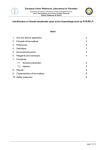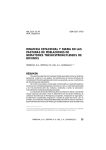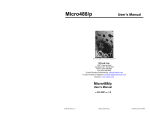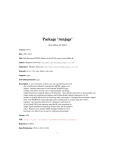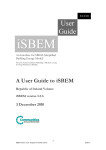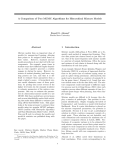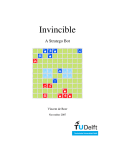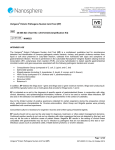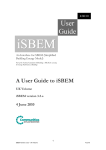Download Using the runjags package
Transcript
runjags: An R Package Providing Interface Utilities,
Model Templates, Parallel Computing Methods and
Additional Distributions For MCMC Models in
JAGS
Matthew J Denwood
University of Copenhagen
Abstract
The runjags package provides a set of interface functions to facilitate running Markov
chain Monte Carlo models in JAGS from within R. Automated calculation of appropriate convergence and sample length diagnostics, user-friendly access to commonly used
graphical outputs and summary statistics, and parallelised methods of running JAGS are
provided. Template model specifications can be generated using a standard lme4-style formula interface to assist users less familiar with the BUGS syntax. Automated simulation
study functions are implemented to facilitate model performance assessment, as well as
drop-k type cross-validation studies, using high performance computing clusters such as
those provided by parallel. A module extension for JAGS is also included within runjags,
providing the Pareto family of distributions and a series of minimally-informative priors
including the DuMouchel and half-Cauchy priors. This vignette is taken from the publication for the runjags package (Denwood [In Review]). It outlines the primary functions
of this package, and gives an illustration of a simulation study to assess the performance
of equivalent model specifications.
Keywords: MCMC, Bayesian, graphical models, interface utilities, JAGS, BUGS, R.
1. Introduction
Over the last decade, the increased availability of computing power has led to a substantial increase in the availability and use of Markov chain Monte Carlo (MCMC) methods
for Bayesian estimation (Gilks, Richardson, and Spiegelhalter 1998). However, such methods
have potential drawbacks if used inappropriately, including difficulties identifying convergence
(Toft, Innocent, Gettinby, and Reid 2007; Brooks and Roberts 1998) and the potential for autocorrelation to decrease the effective sample size of the numerical integration process (Kass,
Carlin, Gelman, and Neal 1998). Although writing MCMC sampling algorithms such as the
Metropolis-Hastings algorithm (Hastings 1970) is relatively straightforward, many users employ software such as the Bayesian analysis Using Gibbs Sampling (BUGS) software variants
WinBUGS and OpenBUGS (Lunn, Thomas, Best, and Spiegelhalter 2000). Just Another
Gibbs Sampler (JAGS; Plummer 2003) is a cross-platform alternative with a direct interface
to R using rjags (Plummer 2013), which can be easily extended with user-specified modules
supporting additional distributions and random number generators (Wabersich and Vandek-
2
runjags: JAGS interface utilities and additional distributions
erckhove 2014). Each of these uses the BUGS syntax to allow the user to define arbitrary
models more easily, which is attractive and attainable for researchers who are more familiar
with traditional modelling techniques. However, many of these less experienced users may
not be aware of the potential issues with MCMC analysis, hence the prominent warning
that ‘MCMC sampling can be dangerous’ in the WinBUGS user manual (Lunn et al. 2000).
Some of this potential risk for inexperienced users can be reduced using a wrapper for the
model-fitting software that analyses the model output for common problems, such as failure
to converge, parameter auto-correlation and effective sample size, which may otherwise be
overlooked by the end-user.
Bayesian statistical methods, such as those used by BUGS and JAGS, also require prior belief
to be incorporated into the model. There are a number of different recommendations for an
appropriate choice of prior distribution under various different circumstances, for example the
half-Cauchy distribution has been recommended as a reasonable choice for standard deviation
parameters within hierarchical models (Gelman 2006; Polson and Scott 2011), and DuMouchel
0
(1994) gives an argument for the use of π(τ ) = (s s+τ
as a prior for a variance parameter τ
)2
0
in meta-analysis models. However, these are not available as built-in distributions in BUGS
or JAGS.
This paper describes the runjags package for R (R Core Team 2014) which can be used to
automate MCMC fitting and summarisation procedures for JAGS models. The functions are
designed to be user-friendly (particularly for those less experienced with MCMC analysis),
and provide a number of features to make the recommended convergence and sample size
checks more obvious to the end user. The runjags package also provides additional distributions to extend the core functionality of JAGS, including the half-Cauchy and DuMouchel
distributions, as well as functions implementing different types of simulation studies to assess the performance of JAGS models. Section 3 gives a worked example of usage to assess
the sensitivity of an over-dispersed count observation model to various minimally-informative
prior distributions. Some prior familiarity with the BUGS programming language and the
underlying MCMC algorithms is assumed. All code shown below is also included in an R file
accompanying the manuscript.
2. Package functions
2.1. Preparation
The core functionality of the runjags package allows a model specified by the user to be run
in JAGS, using the ‘run.jags’ function. The help file for this function gives an overview of the
core functionality of the runjags package and provides links to other relevant functions. All
functions require installation of JAGS, which is open source software available from:
http://mcmc-jags.sourceforge.net
Before running a model for the first time, it is advisable to check the installation of JAGS
and set any desired global settings such as installation locations and warning message preferences using the ‘runjags.options’ function. For example, the following will first test the JAGS
installation, and then set function feedback from runjags and simulation updates from JAGS
to be suppressed for future model runs in this R session:
Matthew J Denwood
3
R> testjags()
You are using R version 3.1.2 (2014-10-31) on a unix machine, with the
X11 GUI
The rjags package is installed
JAGS version 3.4.0 found successfully using the command
'/usr/local/bin/jags'
R> runjags.options(silent.runjags=TRUE, silent.jags=TRUE)
The help file for the ‘runjags.options’ function gives a list of other possible global options,
and instructions on how to set these in the R profile file for permanent use.
2.2. Basic usage
The ‘run.jags’ function requires a valid model definition to the ‘model’ argument and a character string of monitored variables to the ‘monitor’ argument before a model can be run. The
model can be specified in an external text file, or as a character string within R. The former
is likely to be preferable for more complex model formulations, but the latter eliminates the
need for multiple text files. Data will be necessary for most models, and it is highly recommended to provide over-dispersed starting values for multiple chains; the default settings give
a warning if no initial values are provided.
There are a number of ways to provide data and initial values, depending on the preferences
of the user. It is possible for the text file containing the model to also contain data and
initial value “blocks”, in which case these will be automatically imported with the model by
‘run.jags’ and the number of chains inferred from the number of initial value lists found. This
is also compatible with standard WinBUGS or OpenBUGS text files, although the addition of
curly brackets is necessary to demarcate the data and initial value blocks in the same way as
for the model block. It is also necessary to convert any BUGS arrays from row-major order to
column-major order, which is done automatically if the variables are specified inside a list (as
is the case for BUGS, but not for R). To over-ride this setting within a specific data or initial
value block, the user can include #BUGSdata# to ensure all arrays are converted from row- to
column-major order, #Rdata# to ensure none of the arrays are converted, and #modeldata#
to pass the data block directly to JAGS for data transformation (see section 7.0.4 of the JAGS
user manual).
As a basic example, we can use the BUGS Salmonella example from chapter 6.5.2 of the BUGS
book (with thanks to Lunn, Jackson, Best, Thomas, and Spiegelhalter 2012, for permission to
reproduce their model). Simulation-specific options can be provided to the ‘run.jags’ function,
which may include the required burn-in period, sampling length and thinning interval. A basic
model run with a fixed burn-in period (default 4,000 iterations after 1,000 adaptive iterations)
and sampling period (default 10,000 iterations) can be obtained as follows:
R>
+
+
+
filestring <- "
The BUGS book example chapter 6.5.2
The following example has been modified only to include
curly brackets around the Data and Inits specifications
4
+
+
+
+
+
+
+
+
+
+
+
+
+
+
+
+
+
+
+
+
+
+
+
+
+
+
+
+
+
R>
runjags: JAGS interface utilities and additional distributions
Poisson model...
model {
for (i in 1:6) {
for (j in 1:3) {
y[i,j] ~ dpois(mu[i])
}
log(mu[i]) <- alpha + beta*log(x[i] + 10) + gamma*x[i]
}
for (i in 1:6) {
y.pred[i] ~ dpois(mu[i])
}
alpha ~ dnorm(0, 0.0001)
beta ~ dnorm(0, 0.0001)
gamma ~ dnorm(0, 0.0001)
}
Data{
list(y = structure(.Data = c(15,21,29,16,18,21,16,26,33,
27,41,60,33,38,41,20,27,42),
.Dim = c(6, 3)),
x = c(0, 10, 33, 100, 333, 1000))
}
Inits{
list(alpha = 0, beta = 0, gamma = 0)
}
"
results <- run.jags(filestring, monitor=c('alpha','beta','gamma'))
Warning message:
Convergence cannot be assessed with only 1 chain
A single chain was used for this model because only one set of initial values was found in the
example file, resulting in the warning message regarding convergence assessment. The results
of the simulation can be examined using the default print method as follows:
Matthew J Denwood
5
R> results
JAGS model summary statistics from 10000 samples (adapt+burnin = 5000):
Lower95
Median
Upper95
Mean
SD
Mode
alpha
1.8076
2.2279
2.6521
2.2323
0.21633
2.2334
beta
0.18809
0.30563
0.40928
0.30348
0.056648
0.31601
gamma -0.0014336 -0.00096171 -0.00048151 -0.00095585 0.00024311 -0.00096497
MCerr MC%ofSD SSeff
AC.10 psrf
alpha
0.022911
10.6
89 0.80773
-beta
0.0059595
10.5
90 0.83451
-gamma 0.000023138
9.5
110 0.6069
-Total time taken: 0.6 seconds
The results show similar inference to that provided by Lunn et al. (2012), although with
additional information regarding the effective sample size (SSeff), autocorrelation at a lag
of 10 (AC.10), and the potential scale reduction factor (psrf) of the Gelman-Rubin statistic
(Gelman and Rubin 1992) for models with multiple chains. In this case, an insufficient number
of samples have been taken for this highly autocorrelated model (although it is important to
note that the autocorrelation is markedly reduced if the ‘glm’ module is loaded in JAGS).
Displaying the effective sample size with the summary information will alert the user to the
fact that additional steps should be taken before sensible inference can be made.
The data can also be specified to ‘run.jags’ using the data argument, in which case it should
take the format of a named list, data frame, character string as produced by ‘dump.format’,
or a function (with no arguments) returning one of these. Similarly, the initial values can be
specified using the inits argument as a list with length equal to the number of chains, with
each element specifying a named list, data frame or character string for the initial values for
that chain. The initial values may also be specified as a function taking either no arguments
(as for the data) or one argument (specifying the chain number), in which case an additional
‘n.chains’ argument will be required by ‘run.jags’ to determine the number of chains required.
2.3. Alternative usage
To facilitate a more streamlined function call within R, an alternative method of specifying
data and initial values is provided. The model formulation may contain special inline comments including: #data#, which indicates that the comma separated variable names to the
right of the statement are to be included in the simulation as data, and #inits#, which indicates variables for which initial values are to be provided. Any variables specified by #data#
and #inits# will be automatically retrieved from a named list, data frame or environment
passed to the data and inits argument (or function returning one of these), or from the global
environment. Any variable names specified in this way may also match a function returning
an appropriate vector, and in the case of initial values, this function may accept a single argument indicating the chain for which the initial values are to be used. Note that any variables
specified by #data# or #inits# will be ignored if a character string is provided to the data or
inits arguments, which may be useful for temporarily over-riding the values specified in the
6
runjags: JAGS interface utilities and additional distributions
model file. See the ‘dump.format’ function for a way to generate these. In addition to #data#
and #inits#, a number of optional inline comments are supported as follows:
• #monitors# - a comma-separated list of monitored variables to use, which may include
the special variables ‘DIC’ (Spiegelhalter, Best, Carlin, and van der Linde 2002) and
‘PED’ (Plummer 2008), which can be used to assess model fit
• #modules# - a comma-separated list of any JAGS extension modules required, optionally
also specifying the status (e.g. #modules# glm on, dic on)
• #factories# - a comma-separated list of any JAGS factories and types required, optionally also specifying the status (e.g. #factories# mix::TemperedMix sampler on)
• #response# - a single variable name specifying the response variable
• #residual# - a single variable name specifying a variable that represents the residuals
• #fitted# - a single variable name specifying a variable that represents the fitted value
Each of these options can also be supplied directly to the relevant function call in R. An
example of running a model using this style of model specification is as follows:
R>
+
+
+
+
+
+
+
+
+
+
model <- "model {
for(i in 1 : N){ #data# N
Y[i] ~ dnorm(true.y[i], precision) #data# Y
true.y[i] <- coef * X[i] + int #data# X
}
coef ~ dunif(-1000,1000)
int ~ dunif(-1000,1000)
precision ~ dexp(1)
#inits# coef, int, precision, .RNG.seed, .RNG.name
#monitor# coef, int, precision
}"
Simulate the data:
R>
R>
R>
R>
set.seed(1)
N <- 100
X <- seq(1, N, by=1)
Y <- rnorm(N, 2*X + 10, 1)
The following code specifies functions that return initial values (including RNG seeds) for
each chain. The use of ‘switch’ within these functions allows different initial values to be
chosen for chains one and two, ensuring that initial values are over-dispersed.
R>
+
R>
+
coef <- function(chain)
return( switch(chain, "1"= -10, "2"= 10) )
int <- function(chain)
return( switch(chain, "1"= -10, "2"= 10) )
Matthew J Denwood
R>
+
R>
+
R>
+
+
7
precision <- function(chain)
return( switch(chain, "1"= 0.01, "2"= 100) )
.RNG.seed <- function(chain)
return( switch(chain, "1"= 1, "2"= 2) )
.RNG.name <- function(chain)
return( switch(chain, "1" = "base::Super-Duper",
"2" = "base::Wichmann-Hill") )
It is then possible to run the simulation specifying only the model and the number of chains
to use (the monitored variables, data and initial values are specified in the model file and will
be retrieved form our R working environment):
R> results <- run.jags(model, n.chains = 2)
2.4. Extending models
The ‘autorun.jags’ function can be used in the same way as ‘run.jags’, but the burn-in period
and sample length are calculated automatically rather than being directly controlled by the
user. The ‘autorun.jags’ function will continually extend a simulation until convergence as assessed by the Gelman-Rubin statistic (Gelman and Rubin 1992) - has been achieved
for all monitored variables, and will then extend the simulation further to compensate for
any observed autocorrelation. The automated assessment of convergence should be verified
graphically before making inference from models fit to real data, but a fully automated analysis
is useful for simulated data and for reinforcing the importance of convergence assessment for
novice users. The following code will run the same model as above, extending the model as
necessary up to a maximum total elapsed time of one hour:
R> results <- autorun.jags(model, n.chains = 2, max.time='1hr')
Alternatively, an existing model may be extended by the user in order to increase the sample
size of the MCMC chains using either the ‘extend.jags’ or ‘autoextend.jags’ function. For
these functions, the arguments ‘add.monitor’, ‘drop.monitor’ and ‘drop.chain’ are provided
in order to change the monitored variables and number of chains being run. The ‘combine’
argument controls whether the old MCMC chains should be discarded, or combined with the
new chains. For example, the following code will manually extend the existing simulation by
5000 iterations, and then extend the simulation again with automatic control of convergence
and sample size diagnostics:
R> results <- extend.jags(results, sample=5000)
R> results <- autoextend.jags(results)
In the second function call, the automated diagnostics run by ‘autoextend.jags’ determine that
the simulation has converged and already has an adequate sample size, so no additional samples are taken. For more details on these functions including detailed descriptions of the other
arguments and additional examples, consult the help pages for ‘run.jags’ and ‘autorun.jags’.
Once a valid runjags class object has been obtained, the full representation of the model,
data and current status of the random number generators can be saved to a file using the
8
runjags: JAGS interface utilities and additional distributions
‘write.jagsfile’ function. This allows a model to be run from the last sampled values using
the ‘run.jags’ function at a later date, and it may also be instructive to use this function to
examine the format of a syntactically-valid and complete model file that can be read directly
using the ‘run.jags’ function. It is also possible to specify ‘sample=0’ to the original ‘run.jags’
function call, and then subsequently use ‘write.jagsfile’ to produce a model file with the initial
values specified.
2.5. Visualisation methods
The output of these functions is an object of class ‘runjags’. This class is associated with
a number of S3 methods, as well as utility functions for combining multiple runjags objects (‘combine.jags’), and for conversion to & from objects produced by the rjags package
(‘as.runjags’ & ‘as.jags’). Many of these allow a ‘vars’ argument giving a subset of monitored
nodes (using partial matching), as well as a ‘mutate’ argument. This should specify a function
(or a list with first element a function and remaining elements arguments to this function),
and can be used to add new variables to the posterior chains that are derived from the directly
monitored variables in JAGS. This allows the variables to be summarised or extracted as part
of the MCMC objects as if they had been calculated in JAGS, but without the computational
or storage overheads associated with calculating them directly in JAGS. One possible application for this is for pair-wise comparisons of different levels within fixed effects using the
supplied ‘contrasts.mcmc’ function.
The print method displays relevant overview information, including summary statistics for
monitored variables calculated and stored by the ‘run.jags’ function. The summary method
returns a summary table for the monitored variables, which is taken from the stored values
created by ‘run.jags’ if available; otherwise it will be recalculated during the function call.
Alternatively, summary statistics can be recalculated and stored in the runjags object using
the ‘add.summary’ function. There are a series of options available to these summary functions, including ‘vars’ and ‘mutate’ as outlined above, ‘confidence’ which specifies a numeric
vector of confidence intervals to calculate, and ‘custom’ which allows one or more statistics
calculated by a user-supplied function to be appended to the summary statistics. Note that
summary options may also be passed to ‘run.jags’ in order to control the summary statistics
calculated and appended to the runjags object.
The plot method produces a series of relevant plots for the selected variables, including trace
plots, empirical cumulative distribution function plots, histograms, and a cross-correlation
plot, with additional options allowing auto-correlation plots and density plots if desired. Further plot parameters can be specified using the ‘col’ and ‘separate.chains’ arguments, as well
as a named list for each plot type which will be passed to the underlying lattice functions. The
primary intention with these plots is to provide rapid access to commonly used convergence
diagnostics, and plot methods associated with ‘mcmc’ or ‘mcmc.list’ objects may be more
flexible and intuitive for producing more specific graphical output from converged MCMC
chains. The coda package (Plummer, Best, Cowles, and Vines 2006) provides such plotting
methods, as well as many of the underlying functions that calculate the summaries given by
runjags. A typical examination of a simulation output (the default print method, and a plot
output for variable names partially matching the letter ‘c’) could be obtained as follows:
Matthew J Denwood
9
R> results
JAGS model summary statistics from 30000 samples (chains = 2;
adapt+burnin = 5000):
Lower95 Median Upper95
Mean
SD
Mode
MCerr MC%ofSD
coef
1.9935 1.9995
2.006 1.9996 0.0031642 1.9997 0.000076913
2.4
int
9.7534 10.13
10.48 10.131
0.18577 10.13
0.0045395
2.4
precision 0.89024 1.2131 1.5533 1.2213
0.17145 1.1985
0.0012334
0.7
SSeff
AC.10
psrf
coef
1692
0.18952 1.0003
int
1675
0.19662 1.0002
precision 19323 0.0053642
1
Total time taken: 4.5 seconds
R> plot(results, vars = "c", layout = c(3,3))
The standard plot method presents the commonly required information in an easily readable
format (including model fit statistics where available), but the same information can be returned in the form of a numeric matrix using the summary method. To extract additional
information from the runjags object not covered by these summary statistics, see the ‘extract’
method.
2.6. GLMM templates
There are many available frameworks for fitting standard generalised linear mixed models
(GLMM) in R, but new users to MCMC may find that running relatively simple models
in JAGS and comparing the results to those obtained through other software allows them
to better understand the flexibility and syntax of BUGS models. To this end, the runjags
package provides a ‘template.jags’ function which generates model specification files based on
a formula syntax similar to that employed by the well-known lme4 package (Bates, Maechler,
Bolker, and Walker 2014). After generating the template model, the user is encouraged to
examine the model file and make whatever changes are necessary before running the model
using ‘run.jags’. For example, a basic linear model (from the help file for ‘lm’) can be compared
to the output of JAGS as follows:
R>
R>
R>
R>
R>
+
R>
+
counts <- c(18,17,15,20,10,20,25,13,12)
outcome <- gl(3,1,9)
treatment <- gl(3,3)
d.AD <- data.frame(treatment, outcome, counts)
glm.D93 <- glm(counts ~ outcome + treatment,
family = poisson())
template.jags(counts ~ outcome + treatment,
data=d.AD, family='poisson')
% of total
ECDF
1.0
0.8
0.6
0.4
0.2
0.0
1.990 2.000 2.010
Iteration
coef
5000 10000 15000 20000
2.0
precision
Chain 1
coef
Chain 2
precisn
Combined
1.5
5
4
3
2
1
0
1.0
1.5
2.0
precision
1
0
−1
precisn
Iteration
1.985 1.995 2.005
% of total
1.0
2.5
2.0
1.5
1.0
0.5
0.0
coef
1.0
0.8
0.6
0.4
0.2
0.0
coef
1.2
ECDF
1.6
5000 10000 15000 20000
0.8
precision
1.990 2.000 2.010
runjags: JAGS interface utilities and additional distributions
coef
10
Figure 1: A series of plots displayed by the plot method for the runjags class, showing only
parameters partially matched using the letter ‘c’ with plots shown in a 3x3 layout. Multiple
chains are shown using different colours as indicated by the key plot.
Matthew J Denwood
11
Your model template was created at "JAGSmodel.txt" - it is highly
advisable to examine the model syntax to be sure it is as intended
You can then run the model using run.jags("JAGSmodel.txt")
jags.D93 <- run.jags('JAGSmodel.txt')
The results of these comparisons are not displayed here, but show how the same inference is
presented slightly differently in a Bayesian framework. The ‘template.jags’ function supports
Gaussian, (zero-inflated) binomial, (zero-inflated) Poisson and (zero-inflated) negative binomial distributions, as well as linear and fixed effects, 2-way interactions and random intercept
terms specified using the same syntax as lme4. Additional distributions and link functions can
be introduced by manually editing the template model file. All necessary data, initial values,
monitored variables and modules are saved to the model file using the previously described
comment syntax, and the template function also saves information about the response variable, fitted estimates and residuals to the model file, allowing ‘residuals’ and ‘fitted’ methods
to be used with the objects returned by ‘run.jags’.
2.7. JAGS module
In addition to the R code used to facilitate running JAGS models and summarising results, the
runjags package also provides a modular extension to the JAGS language, providing additional
distributions. The module can be loaded using the following command:
R> load.runjagsmodule()
module runjags loaded
This makes the module available to any JAGS model, including those run using the rjags
package. The available distributions extend the Pareto Type I distribution provided within
JAGS to Pareto Types II, III and IV, as well as providing the generalised Pareto distribution,
the Lomax distribution (a special case of the Pareto Type II distribution with µ = 0), and
two distributions advocated for use as ‘minimally informative’ priors for variance parameters:
the DuMouchel distribution (DuMouchel 1994), and the half-Cauchy distribution (Gelman
2006). The usage, probability density function (PDF) and lower bound for the support of
each of the distributions provided by the module is shown in Table 2.7, and an example of
how to use the distributions in this module is given in Section 3.
One limitation of the module provided within runjags is that it is only made available for the
‘rjags’ and ‘rjparallel’ methods when loaded within R. However, a standalone JAGS module
containing the same functions for use with any JAGS installation (independently of R) is
available from http://runjags.sourceforge.net/. This module is named ‘paretoprior’ to
avoid naming conflicts with the internal runjags module, and should install on a variety of
platforms using the standard ‘./configure’, ‘make’ ‘make install’ convention. Binary installers
are also provided for some platforms.
2.8. Method options
There are a number of different methods for calling JAGS from within R using runjags, which
can be controlled using the ‘method’ argument or by changing the global option using the
12
runjags: JAGS interface utilities and additional distributions
Table 1: Distributions provided by the JAGS module included with runjags. The name,
JAGS code with parameterisation, PDF and lower bound of the distributions is shown. All
distributions have an upper bound of ∞ unless otherwise stated.
Name
Usage in JAGS
Pareto I
1
Pareto II
dpar1(alpha,sigma)
α > 0, σ > 0
α
σ
dpar2(alpha,sigma,mu)
α > 0, σ > 0
Density
Lower
α σ α x−(α+1)
σ
σ+x−µ
σ
1
Pareto III
x−µ γ −1
σ
dpar3(sigma,mu,gamma)
σ > 0, γ > 0
Lomax
2
Gen. Par.
dpar4(alpha,sigma,mu,gamma)
α > 0, σ > 0, γ > 0
α
x−µ γ −1
σ
dmouch(sigma)
σ>0
Half Cauchy
dhalfcauchy(sigma)
σ>0
+1
µ
x−µ
σ
1
γ
−(α+1)
+1
µ
α x −(α+1)
1+
σ
σ
1
σ
x−µ −
1+ξ
σ
For ξ = 0:
DuMouchel
−2
1
x−µ γ
σ
γσ
dlomax(alpha,sigma)
α > 0, σ > 0
dgenpar(sigma,mu,xi)
σ>0
µ
γσ
1
Pareto IV
−(α+1)
1
σ
e
0
1
+1
ξ
µ
3
−(x−µ)
σ
σ
(x + σ)2
0
2σ
+ σ2)
π (x2
1
0
This is equivalent to the dpar(alpha,c) distribution and provided for naming consistency
This is referred to as the ‘2nd kind Pareto’ distribution by Van Hauwermeiren and Vose
α σα
(2009); an alternative form for the PDF of this distribution is given by: (x+σ)
α+1
2
3
The Generalised Pareto distribution has an upper bound of x ≤ µ −
σ
ξ
for ξ < 0
Matthew J Denwood
13
‘runjags.options’ function. The main difference between these is that some allow multiple
chains to be run in parallel using separate JAGS models, with automatic pseudo-random
number generation handled by runjags where necessary. The ‘interruptible’, ‘rjags’, ‘parallel’
or ‘bgparallel’ methods are recommended for most situations, but all possible methods and
their advantages & disadvantages are summarised in Table 2. Note that a pre-existing cluster
created using the parallel package can be used by specifying a ‘cl’ argument, and a maximum
number of parallel simulations for these methods can optionally be specified using a ‘n.sims’
argument to the main function call (the default will use a separate simulation per chain,
but it is possible to specify fewer simulations than chains). The model fit statistics are not
available with parallel methods because multiple chains within the same model are required for
calculation of DIC and PED, but these can be obtained using the ‘extract’ method which will
extend the simulation using a single simulation. The adaptation phase is always explicitly
controlled to allow MCMC simulations with the same pseudo-random number seed to be
reproducible regardless of the method used to call JAGS.
Table 2: Methods provided by the runjags package to run simulations in JAGS
Method Name
interruptible
rjags
1,2
background
simple
3
bgparallel
rjparallel
1
1 ∗
1
parallel
snow
1
1
3 ∗
3,4
Description
Method Options
JAGS called using a shell, with output
monitored and displayed within R
–
JAGS called using the rjags package
by and progress.bar: as for
the rjags package
JAGS called as a background process,
with the R prompt returned to the user
–
JAGS called directly using a shell
–
Multiple JAGS instances called using
separate shells to allow chain parallelisation
n.sims: the number of parallel simulations
Multiple JAGS instances called using
separate background processes to allow
chain parallelisation
n.sims: the number of parallel simulations
Multiple rjags models run within R using a parallel cluster
cl: a pre-created cluster to be
used, and n.sims: the number of parallel simulations
Multiple JAGS instances called using
separate shells set up using a parallel
cluster
cl and n.sims: as above, and
remote.jags: the JAGS path
on the cluster nodes
Availability of JAGS modules:
Installed in JAGS, 2 Loadable in the R session, 3 Installed in JAGS (except DIC),
4 Loadable in R code run on the cluster nodes (except DIC)
∗
These methods are not compatible with autorun.jags & autoextend.jags
14
runjags: JAGS interface utilities and additional distributions
The two background methods do not return a completed simulation, but instead create a
folder in the working environment where the simulation results will be written once the JAGS
process has completed. For example, the following code will allow a JAGS simulation to be
run in the background using two processors in parallel, and saving the results in a folder called
’my simulation’ in the current working directory:
R> info <- run.jags(model, n.chains = 2, method = 'bgparallel',
+ keep.jags.files='mysimulation', n.sims = 2)
Starting the simulations in the background...
The JAGS processes are now running in the background
This returns the control of the terminal to the user, who can then carry on working in R
while waiting for the simulation to complete. The default behaviour on completion of the
simulations is to alert the user by emitting a beep from the speakers, but configuration using
‘runjags.options’ allows a shell script file to be executed instead. The ‘info’ variable contains
the name and directory of the simulation, which is given to the user if the object is printed.
The results can be retrieved using either the folder name or the variable returned by the
function that started the simulation:
R> background.results <- results.jags('mysimulation')
If the simulation has not yet completed, the ‘results.jags’ function will display the JAGS output
so that the user can gauge how much longer the simulation will take. Further options for the
‘results.jags’ function include ‘recover.chains’ which allows the results of successful simulations
to be read even if other parallel simulations did not produce output, and ‘read.monitor’ which
allows only a chosen subset of the monitored variables to be read from the MCMC output.
For all methods except ‘rjags’ and ‘rjparallel’, any calls to ‘run.jags’ where the ‘keep.jags.files’
argument is specified will result in a folder being created in the working directory that can be
reimported using ‘results.jags’. Any failed simulations created are also kept using the same
mechanism, and a message is displayed detailing how the user can attempt to recover these
simulations. These failed simulation folders are automatically cleaned up when the R session
is terminated. The ‘failed.jags’ function returns any output captured from JAGS in such cases,
and is helpful to debug model code.
2.9. Simulation studies
One of the principle motivations behind the development of the runjags package is to automate
the analysis of simulated datasets for the purposes of model validation. A common motivation
for this type of analysis is a drop-k validation study, also known as a leave-one-out crossvalidation where k = 1. This procedure re-fits the same model to a single dataset multiple
times, with one or more of the observed data points removed from each re-fit of the model.
This can either be a randomly selected group of a fixed number ‘k’ of data points, or each
individual datapoint in turn. The goal is to evaluate the ability of the model to predict each
observation from the explanatory variables, so that any unusual observations can be identified.
While it is possible to repeatedly use the ‘autorun.jags’ function to analyse multiple datasets,
the higher level ‘run.jags.study’ and ‘drop.k’ functions are provided to automate much of
Matthew J Denwood
15
this process. Large simulation studies are likely to be computationally intensive, but are ideal
candidates for parallelisation. For this reason, parallel computation is built directly into these
functions using the parallel package. This can be used to parallelise the simulation locally, or
to run the simulation on any cluster set up using the snow package (Tierney, Rossini, Li, and
Sevcikova 2013). This allows for the maximisation of the available computing power without
requiring the end user to write any additional code, and includes an initial check to ensure
that the model compiles and runs locally before beginning the parallelised study.
A drop-k study is implemented in runjags using the ‘drop.k’ function as follows. The runjags
class object on which the drop-k analysis will be performed must first be obtained using
the ‘run.jags’ function. Here, we will use the simple linear regression model obtained in
Section 2.3, with the result of ‘run.jags’ contained in the variable ‘results’. The ‘drop.k’
function takes arguments ‘drop’ (indicating the data variables to remove between simulations),
and ‘k’ (indicating the number of data points to drop for each simulation). In this case, a
drop-1 study is run with the number of simulations equal to the number of data points.
All individual simulations are run using the underlying ‘autorun.jags’ function; additional
arguments for ‘autorun.jags’ can be passed through ‘drop.k’ as required. The initial values
for each simulation are taken from the parent simulation, including the observed values of the
removed data points to ensure that the model will compile. The drop-1 study is run and the
results displayed using the following syntax (limited to the first five data-points for brevity):
R> assessment <- drop.k(results, drop='Y[1:5]', k=1)
R> assessment
Values obtained from a drop-k study with a total of 5 simulations:
Y[1]
Y[2]
Y[3]
Y[4]
Y[5]
Target
11.374
14.184
15.164
19.595
20.33
Median
12.149
14.121
16.175
18.078
20.124
Mean Lower95%CI Upper95%CI Range95%CI Within95%CI
12.14
10.34
13.985
3.6443
1
14.115
12.256
15.954
3.6985
1
16.167
14.431
18.098
3.6673
1
18.069
16.276
19.898
3.6213
1
20.116
18.261
21.932
3.6708
1
Y[1]
Y[2]
Y[3]
Y[4]
Y[5]
AutoCorr(Lag10)
-0.00059858
0.004172
0.011319
-0.00099754
-0.0044123
Average time taken: 2.9 seconds (range: 2.7 seconds - 3.1 seconds)
Average adapt+burnin required: 5000 (range: 5000 - 5000)
Average samples required: 10685 (range: 10000 - 11229)
The results show the 95% confidence interval (CI) for each datapoint obtained from the
corresponding simulation where this datapoint was removed, which in this case indicates
that the first five data-points were predicted reasonably well. For drop-k cross-validation
16
runjags: JAGS interface utilities and additional distributions
with ‘k’ greater than 1, the indicated number of data points will be randomly removed from
each simulation and the average values for the corresponding summary statistics from each
data point will be shown. In this case, an argument for ‘simulations’ must also be provided.
Additional arguments to ‘autorun.jags’ can also be provided to the ‘drop.k’ function. For
example, the following syntax will run 100 simulations with a random selection of 2 of the 5
first five data-points removed from each:
R> assessment <- drop.k(results, drop='Y[1:5]', k=2, simulations=100,
+ method='simple', psrf.target=1.1)
R> assessment
Average values obtained from a drop-k study with a total of 100 simulations:
Y[1]
Y[2]
Y[3]
Y[4]
Y[5]
Target Av.Median Av.Mean Av.Lower95%CI Av.Upper95%CI Av.Range95%CI
11.374
12.163
12.16
10.319
13.975
3.6557
14.184
14.138 14.134
12.29
15.971
3.6818
15.164
16.161 16.157
14.323
17.969
3.6464
19.595
18.089 18.088
16.27
19.903
3.6329
20.33
20.134 20.129
18.315
21.965
3.6507
Y[1]
Y[2]
Y[3]
Y[4]
Y[5]
Prop.Within95%CI Av.AutoCorr(Lag10) Simulations
1
0.0040714
42
1
0.0037887
37
1
0.0039891
48
1
0.00040502
34
1
0.0019401
39
Average time taken: 11 seconds (range: 6.6 seconds - 12.6 seconds)
Average adapt+burnin required: 5000 (range: 5000 - 5000)
Average samples required: 10486 (range: 10000 - 11571)
In the latter case, inference was made on each datapoint in several different datasets, so
the results present the mean values of each summary statistic obtained from the multiple
simulations.
The ‘drop.k’ function is a wrapper for the ‘run.jags.study’ function, which can be used to
perform various different types of simulation study. This function takes the following arguments: the number of datasets to analyse, the model to use, a function to produce data that
will be provided to each simulation, and a named list of ‘target’ variables with true values
representing parameters to be monitored and used to summarise the output of the simulation.
Inline #monitor# statements can be used as with ‘run.jags’, and any target variables are also
automatically monitored. Any variables specified using the inline #data# statement will be
retrieved from the working environment as usual and will be common to all simulations - data
which is intended to change between simulations must therefore be provided using the ‘data
function’ argument instead. Initial variables can be specified using #inits# in the model
file, but it is also necessary to pass a character string of all variable names required to the
‘export.cluster’ argument to ensure these variables are visible on the cluster nodes. It may be
Matthew J Denwood
17
preferable to specify initial values as a function, to which the data will be made available by
‘run.jags’ at run time (this may be required in cases where the choice of appropriate initial
values depends on the values in the data). An illustration of the ‘run.jags.study’ function is
provided in Section 3.
3. Illustration of usage with a simulation study
Here we will consider a worked example of a simulation study analysis using runjags, in order
to assess the performance of two equivalent model formulations with two different ‘minimallyinformative’ priors. The application is an over-dispersed count model, the use of which is
widespread in many biological fields (Bolker, Brooks, Clark, Geange, Poulsen, Stevens, and
White 2009), including parasitology (Wilson, Grenfell, and Shaw 1996; Wilson and Grenfell
1997; Shaw, Grenfell, and Dobson 1998), where Bayesian methods of analysis have been shown
to provide more robust inference than traditional methods (Denwood, Stear, Matthews, Reid,
Toft, and Innocent 2008; Denwood, Reid, Love, Nielsen, Matthews, McKendrick, and Innocent
2010).
3.1. Model formulation and assessment
The gamma distribution is parameterised in JAGS and BUGS by the shape (α) and rate (β)
parameters, with the expectation given by αβ and variance given by βα2 . This distribution can
be used to describe underlying variability in a Poisson observation, representing an unknown
amount of over-dispersion between observations. In this situation the extra-Poisson coefficient
of variation cv is a useful measure of the variability ofqthe underlying gamma distribution,
and is a simple function of the shape parameter: cv =
1
α
A candidate JAGS Model A (using inline data and monitor statements to be detected by
runjags) is as follows:
R> ModelA <- "model{
+
+
for(i in 1:N){
+
Count[i] ~ dpois(lambda[i])
+
lambda[i] ~ dgamma(shape, rate)
+
}
+
+
shape ~ dmouch(1)
+
mean ~ dmouch(1)
+
rate <- shape / mean
+
+
#data# N
+
#modules# runjags
+
#monitor# mean, shape
+}"
This model allows each observed Count to follow a Poisson distribution with lambda drawn
from a gamma distribution with shape parameter to be estimated, and rate parameter calcu-
18
runjags: JAGS interface utilities and additional distributions
lated from the shape parameter and the mean of the distribution, which is also to be estimated.
The prior distribution used for the mean and shape parameters is the DuMouchel prior distribution as shown in Table 2.7 - this distribution is provided by the runjags extension module
which can be loaded using the #modules# tag. Here we use the same minimally-informative
prior distribution for both shape and mean parameters. The #data# statement is used to
include N as data that does not change between simulations. The Count variable is also
observed, but will vary between simulations so is not retrieved from R memory using #data#.
An alternative formulation of this same model could be provided using a negative binomial
distribution rather than a gamma mixture of Poisson distributions, as represented in Model
B:
R> ModelB <- "model{
+
+
for(i in 1:N){
+
Count[i] ~ dnegbin(prob, shape)
+
}
+
+
shape ~ dmouch(1)
+
mean ~ dmouch(1)
+
prob <- shape / (shape + mean)
+
+
#data# N
+
#modules# runjags
+
#monitor# mean, shape
+}"
In this model, the same priors are placed on the parameters shape and mean, but the negative binomial distribution is parameterised by a probability p in place of the parameter
mean. However, the gamma-Poisson and negative binomial distributions are equivalent (see
Appendix A), and these models share the same prior distributions for the two parameters of
interest. The two might therefore be expected to give equivalent inference.
The posterior coverage and autocorrelation of these models can be assessed using simulation
studies, with data generated from a distribution with a mean of 2, cv of 1.1, and sample size
of 20. These values are chosen to exaggerate any model performance issues by providing a
comparatively small dataset with a large number of zero observations, and are similar to those
typically found in veterinary parasitological datasets (Denwood 2010). The two parameters
of interest are the mean parameter which is directly monitored in the model, and the cv
parameter which is a function of the monitored shape parameter. Rather than calculate the
cv parameter in JAGS, this can be calculated more efficiently in R using a mutate function:
R> getcv <- function(x){
+
return( list( cv = sqrt(1 / x[,'shape']) ) )
+ }
The model performance assessment can be automated using ‘run.jags.study’ by creating a
function to return a pre-generated simulated dataset for each simulation:
Matthew J Denwood
19
R> N <- 20
R> S <- 1000
R> truemean <- 2
R> truecv <- 1.1
R> trueshape <- 1/truecv^2
R> truerate <- trueshape / truemean
R> set.seed(1)
R> alldata <- lapply(1:S, function(x){
+
return( rpois(N, rgamma(N, trueshape, rate = truerate) ) )
+ })
R> datafunction <- function(i) return( list( Count = alldata[[i]] ) )
In this case we specify the initial values as a function, illustrating the potential to make use
of the stochastically-generated data while creating the initial values within the function:
R> initsfunction <- function(chain){
+
stopifnot(data$N==20)
+
stopifnot(chain %in% c(1,2))
+
shape <- c(0.1, 10)[chain]
+
mean <- c(10, 0.1)[chain]
+
.RNG.seed <- c(1,2)[chain]
+
.RNG.name <- c("base::Super-Duper",
+
"base::Wichmann-Hill")[chain]
+
return(list(shape=shape, mean=mean,
+
.RNG.seed=.RNG.seed,
+
.RNG.name=.RNG.name))
+ }
Finally, a parallel cluster with 10 nodes is set up on the local machine, before the two simulation studies are run on this cluster using the same data. The ‘run.jags.study’ function will
check each of the models locally using a single randomly chosen dataset to ensure that the
model is valid before it is passed to the cluster:
R> library("parallel")
R> cl <- makeCluster(10)
R> resultsA <- run.jags.study(S, ModelA, datafunction,
+ targets = list( mean = truemean, cv = truecv ),
+ cl = cl, inits = initsfunction, n.chains = 2, mutate = getcv)
R> resultsB <- run.jags.study(S, ModelB, datafunction,
+ targets = list( mean = truemean, cv = truecv ),
+ cl = cl, inits = initsfunction, n.chains = 2, mutate = getcv)
Each function call returns an object of class ‘runjagsstudy’, with a default print method that
summarises the results as for ‘drop.k’:
20
runjags: JAGS interface utilities and additional distributions
R> resultsA
Average values obtained from a JAGS study with a total of 1000 simulations:
Target Av.Median Av.Mean Av.Lower95%CI Av.Upper95%CI Av.Range95%CI
mean
2
1.9682 2.0758
0.99781
3.3554
2.3576
cv
1.1
1.0626 1.0908
0.52571
1.6986
1.1729
mean
cv
Prop.Within95%CI Av.AutoCorr(Lag10) Simulations
0.928
0.04491
1000
0.928
0.1904
1000
Average time taken: 3 seconds (range: 2.1 seconds - 8.6 seconds)
Average adapt+burnin required: 5484 (range: 5000 - 49000)
Average samples required: 10038 (range: 10000 - 15638)
R> resultsB
Average values obtained from a JAGS study with a total of 1000 simulations:
mean
cv
Target Av.Median Av.Mean Av.Lower95%CI Av.Upper95%CI Av.Range95%CI
2
1.9634 2.0695
0.99998
3.3317
2.3317
1.1
1.0624 1.0892
0.52329
1.6909
1.1676
Prop.Within95%CI Av.AutoCorr(Lag10) Simulations
mean
0.927
0.016397
1000
cv
0.932
0.039312
1000
Average time taken: 2.9 seconds (range: 1.4 seconds - 5.7 seconds)
Average adapt+burnin required: 5220 (range: 5000 - 16000)
Average samples required: 10000 (range: 10000 - 10000)
The inference made from the two models was generally similar, except that the autocorrelation for both parameters was reduced for Model B, meaning that on average fewer samples
were required for this model. As would be expected, the 95% confidence intervals for both
parameters identified the true value approximately 95% of the time.
3.2. Sensitivity to prior distributions
The ability to incorporate prior information is an advantage of Bayesian methods, but there is
often a variety of potential distributions that could be equally justifiable in a given situation.
The choice between these possibilities is known to affect the shape of the posterior in some
situations (Lele and Dennis 2009), particularly when the information in the data is relatively
sparse. In particular, there are various different minimally-informative priors advocated for
use with variance parameters in hierarchical models, including the Gamma(0.001,0.001) distribution which is characterised by a mean of one and a very large variance. The sensitivity
of a model to the choice of priors between this gamma prior and the DuMouchel prior can
Matthew J Denwood
21
Parameter
Priors: mean | shape
Mean
CI Range
Within CI
AC10
Simulations
mean
mean
mean
mean
dmouch | dmouch
dmouch | dgamma
dgamma | dmouch
dgamma | dgamma
2.070
2.072
2.149
2.158
2.332
2.342
2.523
2.562
0.927
0.916
0.932
0.926
0.016
0.021
0.035
0.042
1000
1000
1000
1000
cv
cv
cv
cv
dmouch | dmouch
dmouch | dgamma
dgamma | dmouch
dgamma | dgamma
1.089
1.067
1.093
1.073
1.168
1.271
1.173
1.279
0.932
0.880
0.929
0.883
0.039
0.092
0.041
0.090
1000
1000
1000
1000
Table 3: Average values for the inference on the mean parameter (true value 2) and cv
parameter (true value 1.1) obtained from a negative binomial MCMC model formulation
using DuMouchel and gamma priors for the mean and shape parameters.
be evaluated using the ‘run.jags.study’ function, with a total of four candidate sets of priors
(using each combination of DuMouchel and gamma distributions for the mean and shape
parameters). These were applied to the same 1,000 simulated datasets using Model B and
very similar R code to that given above. The results of these four simulation studies are
shown in Table 3. There were small but noticeable differences between the inference made
for both parameters using these prior distributions. The bias and autocorrelation were both
approximately doubled for the mean parameter between DuMouchel and gamma priors, and
more substantial changes in bias and autocorrelation were seen between priors for the cv
parameter. In addition, the 95% confidence intervals for the cv parameter have less than
90% coverage when using the gamma prior, despite a slightly larger average range of these
confidence intervals relative to the DuMouchel prior.
3.3. Discussion
The results presented here demonstrate the utility of simulation studies facilitated by the
runjags package to evaluate the relative performance of alternative model formulations and
the effect of prior distribution choices. In this case, the DuMouchel prior out-performed the
more standard gamma prior, and it also possesses properties that are theoretically desirable
for a minimally-informative distribution, such as invariance to inverse transformation, infinite
variance and a mode of 0. DuMouchel (1994) proposed this prior for use with variance
parameters in hierarchical models, but it has also been used in situations outside the metaanalysis application for which it was originally devised (for example Phillips, Tam, Conti,
Rodrigues, Brown, Iturriza-Gomara, Gray, and Lopman 2010; Conti, Presanis, van Veen,
Xiridou, Donoghoe, Rinder Stengaard, and De Angelis 2011; Yin, Conti, Desai, Stafford,
Slater, Gill, and Simms 2013). Christiansen and Morris (1997) also used the same distribution
as a prior for a hierarchical regression model, and Daniels (1999) uses a uniform shrinkage
prior which is equivalent to the DuMouchel distribution. Although this connection is not
stated directly by DuMouchel (1994), the distribution is equivalent to a Lomax distribution
with τ = x, s0 = σ and α = 1, and therefore to a Pareto type II distribution with τ = x,
s0 = σ, α = 1 and µ = 0 (Table 2.7). The choice of σ dictates the median - a value of 1 is
advocated since this also ensures invariance to the inverse transformation of τ , so this prior is
22
runjags: JAGS interface utilities and additional distributions
equivalent in terms of variance and precision. The half-Cauchy distribution has a similar form
to the DuMouchel distribution, and has also been suggested for use as a prior for variance
parameters (Gelman 2006; Polson and Scott 2011).
Although it is also possible to extend other variants of (BUGS), JAGS is fully open source and
written in C++, making extension modules such as the one provided by runjags much easier
to implement. A very useful tutorial on writing and installing a standalone JAGS module is
provided by Wabersich and Vandekerckhove (2014), but it is arguably more straightforward
to implement a shared JAGS library inside an R package. The configure script provided inside
the runjags package sets up the necessary environmental variables for compilation on any
platform, and can be used as a template for creating additional extension modules within R
packages.
4. Summary
There are several advantages to using MCMC, but also some potential disadvantages associated with failure to identify poor convergence and high Monte Carlo error. The runjags
package attempts to partially safeguard against some of these difficulties by calculating and
automatically reporting convergence and sample length diagnostics every time a JAGS model
is run, and provides a more user-friendly way to access commonly used visual convergence
diagnostics and summary statistics. Implementations of common GLMM are provided using
a standard formula-style interface, in order to encourage new users to explore the potential
of MCMC inference without having to generate the full code for the model themselves. A
further application of the runjags package is in implementing simulation studies so that model
formulations and prior specifications can be validated using techniques such as drop-k crossvalidation studies. Given that the inference made using JAGS and BUGS can be sensitive
to subtly different model specifications and prior distributions, a user-friendly mechanism to
perform these types of analyses is potentially very useful.
Acknowledgments
The author is grateful to the anonymous referees for their very useful comments and suggestions, to Stefano Conti for useful discussions regarding the Pareto family of distributions,
to Vaetta Editing for proofreading this manuscript, and to the authors of ‘The BUGS book’
(Lunn et al. 2012) for kind permission to use the Salmonella example.
References
Bates D, Maechler M, Bolker B, Walker S (2014). “lme4: Linear mixed-effects models using
Eigen and S4. R package version 1.1-7. http://cran.r-project.org/package=lme4.”
Bolker BM, Brooks ME, Clark CJ, Geange SW, Poulsen JR, Stevens MHH, White JSS (2009).
“Generalized Linear Mixed Models: a Practical Guide for Ecology and Evolution.” Trends
in Ecology & Evolution, 24(3), 127–35. ISSN 0169-5347. URL http://dx.doi.org/10.
1016/j.tree.2008.10.008.
Matthew J Denwood
23
Brooks SP, Roberts GO (1998). “Assessing Convergence of Markov Chain Monte Carlo Algorithms.” Statistics and Computing, 8, 319–333.
Christiansen CL, Morris CN (1997). “Hierarchical Poisson Regression Modeling.” Journal of the American Statistical Association, 92, 618–632. ISSN 0162-1459. doi:
10.1080/01621459.1997.10474013. URL http://www.tandfonline.com/doi/abs/10.
1080/01621459.1997.10474013.
Conti S, Presanis AM, van Veen MG, Xiridou M, Donoghoe MC, Rinder Stengaard A, De
Angelis D (2011). “Modeling of the HIV Infection Epidemic in the Netherlands: a MultiParameter Evidence Synthesis Approach.” The Annals of Applied Statistics, 5(4), 2359–
2384. ISSN 1932-6157. URL http://dx.doi.org/10.1214/11-AOAS488.
Daniels M (1999). “A prior for the variance in hierarchical models.” The Canadian Journal
of Statistics, 27, 567–578. ISSN 03195724. doi:doi:10.2307/3316112. URL http://
onlinelibrary.wiley.com/doi/10.2307/3316112/abstract.
Denwood, MJ (In Review). “runjags: An R Package Providing Interface utilities, model
templates, parallel computing methods and additional distributions for MCMC models in
JAGS.” Journal of Statistical Software.
Denwood MJ (2010). A Quantitative Approach to Improving the Analysis of Faecal Worm
egg Count Data. Doctoral thesis, University of Glasgow. URL http://www.gla.ac.uk/
media/media%5C_149338%5C_en.pdf.
Denwood MJ, Reid SWJ, Love S, Nielsen MK, Matthews L, McKendrick IJ, Innocent GT
(2010). “Comparison of Three Alternative Methods for Analysis of Equine Faecal egg Count
Reduction Test Data.” Preventive Veterinary Medicine, 93(4), 316–23. ISSN 1873-1716.
URL http://dx.doi.org/10.1016/j.prevetmed.2009.11.009.
Denwood MJ, Stear MJ, Matthews L, Reid SWJ, Toft N, Innocent GT (2008). “The Distribution of the Pathogenic Nematode Nematodirus battus in Lambs is Zero-Inflated.” Parasitology, 135(10), 1225–1235. ISSN 1469-8161 (Electronic). URL http://dx.doi.org/10.
1017/S0031182008004708.
DuMouchel W (1994). “Hierarchical Bayes Linear Models for Meta-Analysis.” Technical
Report 27, National Institute of Statistical Sciences. URL http://www.niss.org/sites/
default/files/pdfs/technicalreports/tr27.pdf.
Gelman A (2006). “Prior Distributions for Variance Parameters in Hierarchical Models.”
Bayesian Analysis, 1(3), 515–533.
Gelman A, Rubin DB (1992). “Inference from Iterative Simulation Using Multiple Sequences.”
Statistical Science, 7(4), 457–472. URL http://www.jstor.org/stable/2246093.
Gilks WR, Richardson S, Spiegelhalter DJ (1998). Markov Chain Monte Carlo in Practice.
Chapman and Hall, Boca Raton, Fla. ISBN 0412055511. URL http://www.loc.gov/
catdir/enhancements/fy0646/98033429-d.html.
Hastings WK (1970). “Monte Carlo Sampling Methods Using Markov Chains and Their
Applications.” Biometrika, 57(1), 97–109. URL http://dx.doi.org/10.1093/biomet/
57.1.97.
24
runjags: JAGS interface utilities and additional distributions
Kass RE, Carlin BP, Gelman A, Neal RM (1998). “Markov Chain Monte Carlo in Practice:
a Roundtable Discussion.” The American Statistician, 52(2), 93–100.
Lele SR, Dennis B (2009). “Bayesian Methods for Hierarchical Models: are Ecologists Making
a Faustian Bargain?” Ecological Applications : a Publication of the Ecological Society of
America, 19(3), 581–4. ISSN 1051-0761. URL http://www.ncbi.nlm.nih.gov/pubmed/
19425420.
Lunn D, Jackson C, Best N, Thomas A, Spiegelhalter D (2012). The BUGS book: A practical
introduction to Bayesian analysis. CRC press.
Lunn DJ, Thomas A, Best N, Spiegelhalter D (2000). “WinBUGS - a Bayesian Modelling
Framework: Concepts, Structure, and Extensibility.” Statistics and Computing, 10(4),
325–337. ISSN 0960-3174. URL http://dx.doi.org/10.1023/A:1008929526011.
Phillips G, Tam CC, Conti S, Rodrigues LC, Brown D, Iturriza-Gomara M, Gray J, Lopman
B (2010). “Community Incidence of Norovirus-Associated Infectious Intestinal Disease in
England: Improved Estimates Using Viral Load for Norovirus Diagnosis.” American Journal
of Epidemiology, 171(9), 1014–22. ISSN 1476-6256. URL http://dx.doi.org/10.1093/
aje/kwq021.
Plummer M (2003). “JAGS : A Program for Analysis of Bayesian Graphical Models Using Gibbs Sampling JAGS : Just Another Gibbs Sampler.” In Proceedings of the 3rd International Workshop on Distributed Statistical Computing (DSC 2003), pp. March 20–
22,Vienna, Austria. ISSN 1609–395X. ISSN 1609395X. doi:10.1.1.13.3406. URL
http://www.ci.tuwien.ac.at/Conferences/DSC-2003/Drafts/Plummer.pdf.
Plummer M (2008). “Penalized loss functions for Bayesian model comparison.” Biostatistics,
9, 523–539. ISSN 14654644. doi:10.1093/biostatistics/kxm049.
Plummer M (2013). rjags: Bayesian Graphical Models Using Mcmc. URL http://cran.
r-project.org/package=rjags.
Plummer M, Best N, Cowles K, Vines K (2006). “CODA: Convergence Diagnosis and Output Analysis for MCMC.” R News, 6(1), 7–11. URL http://cran.r-project.org/doc/
Rnews/.
Polson NG, Scott JG (2011). “On the Half-Cauchy Prior for a Global Scale Parameter.”
Cornell University Library: arXiv.org. URL http://arxiv.org/abs/1104.4937.
R Core Team (2014). R: A Language and Environment for Statistical Computing. R Foundation for Statistical Computing, Vienna, Austria. URL http://www.R-project.org/.
Shaw DJ, Grenfell BT, Dobson AP (1998). “Patterns of Macroparasite Aggregation in Wildlife
Host Populations.” Parasitology, 117, 597–610. ISSN 0031-1820.
Spiegelhalter DJ, Best NG, Carlin BP, van der Linde A (2002). “Bayesian Measures of Model
Complexity and Fit.” Journal of the Royal Statistical Society. Series B (Statistical Methodology), 64(4), 583–639. ISSN 13697412. URL http://www.jstor.org/stable/3088806.
Tierney L, Rossini AJ, Li N, Sevcikova H (2013). snow: Simple Network of Workstations.
URL http://cran.r-project.org/package=snow.
Matthew J Denwood
25
Toft N, Innocent GT, Gettinby G, Reid SWJ (2007). “Assessing the Convergence of Markov
Chain Monte Carlo Methods: an Example from Evaluation of Diagnostic Tests in Absence
of a Gold Standard.” Preventive Veterinary Medicine, 79(2-4), 244–256. ISSN 0167-5877.
URL http://dx.doi.org/10.1016/j.prevetmed.2007.01.003.
Van Hauwermeiren M, Vose D (2009). A Compendium of Distributions. Vose Software, Ghent,
Belgium. URL http://www.vosesoftware.com/content/ebook.pdf.
Wabersich D, Vandekerckhove J (2014). “Extending JAGS: a tutorial on adding custom
distributions to JAGS (with a diffusion model example).” Behavior research methods, 46(1),
15–28. ISSN 1554-3528. doi:10.3758/s13428-013-0369-3. URL http://www.ncbi.nlm.
nih.gov/pubmed/23959766.
Wilson K, Grenfell BT (1997). “Generalized Linear Modelling for Parasitologists.” Parasitology Today, 13(1), 33–38. ISSN 0169-4758. URL http://dx.doi.org/10.1016/
S0169-4758(96)40009-6.
Wilson K, Grenfell BT, Shaw DJ (1996). “Analysis of Aggregated Parasite Distributions: a
Comparison of Methods.” Functional Ecology, 10, 592–601.
Yin Z, Conti S, Desai S, Stafford M, Slater W, Gill ON, Simms I (2013). “The Geographic
Relationship Between Sexual Health Deprivation and the Index of Multiple Deprivation
2010: a Comparison of two Indices.” Sexual Health, 10(2), 102–11. ISSN 1448-5028. URL
http://dx.doi.org/10.1071/SH12057.
26
runjags: JAGS interface utilities and additional distributions
A. Formulation of the negative binomial as a gamma-Poisson
The compound probability mass function of a Poisson distribution (with mean λ) integrated
over a gamma distribution (with shape and scale parameters α and β respectively) is given
in Equation 1.
Z
f (x; α, β) =
0
∞
λx −λ α 1 α−1 −βλ
e .β
λ
e
dλ
x!
Γ(α)
(1)
Substituting α = r and β = 1−p
p into Equation 1 gives Equation 2, which can be re-written
and simplified to Equation 4.
λx −λ
1 − p r 1 r−1 − 1−p
λ
p
f (x; r, p) =
e .
λ e
dλ
x!
p
Γ(r)
0
Z ∞
(1−p)λ
(1 − p)r
x+r−1 −λ − p
λ
e
e
dλ
=
x! pr Γ(r) 0
Z
∞
(1 − p)r
−λ
=
λx+r−1 e p dλ
r
x! p Γ(r) 0
R∞
= 0 tb e−at dt for a = p1 , b = x + r − 1 and t
Substituting the gamma function Γ(b+1)
ab+1
into Equation 4 gives Equation 5.
Z
∞
(1 − p)r Γ(x + r − 1 + 1)
f (x; r, p) =
x+r−1+1
x! pr Γ(r)
1
(2)
(3)
(4)
=λ
(5)
p
r
(1 − p)
Γ(x + r) px+r
x! pr Γ(r)
Γ(x + r) x
=
p (1 − p)r
x! Γ(r)
=
(6)
(7)
Equation 7 is the probability mass function of the negative binomial distribution defining the
number of successes x before r failures with a probability of success p, which is therefore
pr
and shape
exactly equivalent to a gamma-Poisson compound distribution with mean αβ = 1−p
parameter α = r.
Affiliation:
Matthew J Denwood
Department of Large Animal Sciences
Section for Animal Welfare and Disease Control
Faculty of Health and Medical Sciences
University of Copenhagen
Denmark
E-mail: [email protected]
URL: http://iph.ku.dk/english/employees/?pure=en/persons/487288/


























